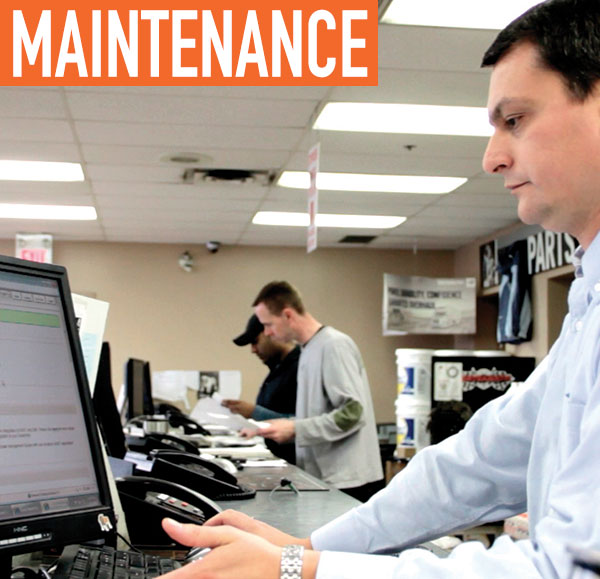The service supply chain you rely on to efficiently manage maintenance and repairs at internal shops and with dealer and third-party service providers can be complex. Access to real-time information during service events improves decision making and provides the foundation for reporting and analytics on the effectiveness of your operations. Managing service events more effectively can reduce downtime, maintenance expenses, and total cost of ownership.
“It’s not unusual to see fleets using a mix of providers for vehicle and equipment service,” says Michael Riemer, VP products and channel marketing at Decisiv, Inc., a provider of Service Relationship Management (SRM) technology for commercial assets. “While using different shops is an opportunity to improve service event management, a communication and collaboration system-based approach is required to effectively track, manage, and measure maintenance performance.
“As much as 80 percent of a service event is not related to turning a wrench,” Riemer states. “A lot of the non-productive time that contributes to fleet downtime is caused by a lack of real-time access to key information during service events and by inefficient communication. These inefficiencies have a significant bottom-line financial impact, beyond actual repair costs.”
Among them, Riemer includes:
- Additional maintenance must be scheduled or breakdowns occur because preventive maintenance services were not completed on time.
- Warranty opportunities were missed because information on coverage was not available at the point of service or recent repair data had not yet been entered.
- Assets may sit idle because a repair was not approved in a timely fashion or the operations department was not made aware that a vehicle was ready to be put back in service.
- Costs for spare units or rentals may be incurred to ensure customer service needs are met.
- Ineffective approval processes result in estimate-invoice mismatches and overpayment, as well as repeat repairs.
“The solution is effective communication and information flow processes between fleets, internal shops, and service providers,” Riemer says. “Service Relationship Management incorporates in-context vehicle and equipment specification and service history information, integrates with fleet maintenance management software and telematics solutions, and provides for communication during service events, regardless of asset type, service provider, or location.”

Servicing a vehicle generally only accounts for 20 percent of shop-time, while the remaining 80 percent is mostly logistics.
FRICTIONLESS DATA
SRM is driven by the frictionless exchange of data across the entire service supply chain. In that regard, according to Riemer, the value of Vehicle Maintenance Reporting Standards (VMRS) codes can’t be underemphasized. Developed by the Technology & Maintenance Council (TMC) of American Trucking Associations, VMRS has become the universal reporting language in truck maintenance operations.
“The coding convention describes assets by manufacturer, type, component and parts, service events, repair operations, and other critical maintenance-related operations. It is continually updated as new technologies and components are introduced,” Riemer explains. “VMRS allows fleets, service providers, and manufacturers to have a complete understanding of what occurred during a repair, without needing extensive written communications. The codes also provide for the organization of complex data in a structured format. This enables more effective specification and asset retirement decisions, improves budgeting and planning, enables better triage and shop scheduling, as well as event performance monitoring and reporting.
“The ability to ensure the right information is captured during the service and repair process is the foundation of a quality fleet maintenance operation,” Riemer continues. “Using SRM technology for the management of service and repair events ensures the right data is captured in real time to improve decision making and is available after the fact to help identify trends through reporting and analytics.”

The Decisiv Dashboard shows data regarding maintenance and repairs.
CONNECTED SUPPLY CHAIN
Fleets today have an opportunity to expand their ecosystem of OEM partners and third-party service providers. The value of integrated business applications is found in requiring limited user interaction to access and acquire information from telematics and remote diagnostic systems, OEM parts, warranty and build information, and electronic estimate and invoice information.
“The more information available at the point of service, across all service supply chain constituents, the better for everyone,” Riemer remarks. “Whether it’s more timely policy decisions, technical support from key OEMs, or real-time service event data, having a connected ecosystem drives uptime and reduces costs.”
The Decisiv Network Alliance is a leading group of vehicle and component manufacturers, service networks, telematics providers, fleet maintenance, and other business applications committed to sharing information and driving uptime. This includes leading vehicle manufacturers (Mack, Volvo, Hino), telematics vendors (PeopleNet, Telogis, Geotab), business system providers (Procede, CDK, Karmak, TMW), as well as third-party maintenance call centers (Ryder, FleetNet America, TTN Solutions).
Fleets are under constant pressure to cut costs and reduce downtime. Effective service event management enabled by an automated system and a connected service supply chain can improve communications and collaboration and provide the transparency necessary to lower costs and maximize uptime.
FOR MORE INFORMATION:
Seth Skydel has more than 30 years of truck-related publication experience. He has held editorial roles at numerous national business-to-business publications focusing on fleet and transportation management, vehicle and information technology, and industry trends and issues.
_______________________________________________________________________
MODERN WORKTRUCK SOLUTIONS: FEBRUARY 2016 ISSUE
Did you enjoy this article?
Subscribe to the FREE Digital Edition of Modern WorkTruck Solutions magazine.
![]()




